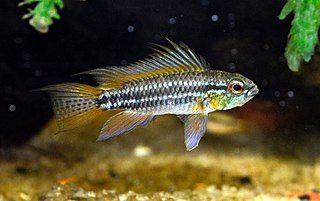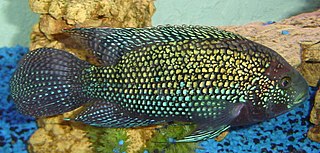
Crenicichla is a genus of cichlids native to South America commonly known as the pike cichlids. They are found in most tropical and subtropical freshwater habitats between the Andes and the Atlantic.

Apistogramma is a large genus of freshwater fish in the family Cichlidae native to South America, but also commonly kept in aquariums. They are dwarf cichlids that mostly feed on tiny animals and have breeding behaviors that vary depending on the exact species.

Aequidens is a genus of fish in the family Cichlidae found in South America. Formerly a wastebasket genus, as presently defined Aequidens is largely restricted to the Amazon Basin, Orinoco Basin and river basins in The Guianas. The only exceptions are A. plagiozonatus which also occurs in the Paraná Basin, and A. tetramerus which also occurs in the Parnaíba River.
The Esmeraldas River is a 210 km (130 mi) river in northwestern Ecuador that flows into the Pacific Ocean at the city of Esmeraldas. Among its tributaries is the Guayllabamba River which drains Quito. Charles Marie de la Condamine sailed up it and then climbed the Andes Mountains when on the Ecuadorian Expedition that left France in May 1735.

Geophagus is a genus of cichlids that mainly live in South America as far south as Argentina and Uruguay, but a single species, G. crassilabris is from Panama. They are found in a wide range of freshwater habitats. They are part of a group popularly known as eartheaters and mostly feed by picking up mouthfuls of sediment to sift out food items such as invertebrates, plant material and detritus. The largest species reach up to 28 cm (11 in) in standard length. They are mostly kept in aquariums.

Mikrogeophagus is a genus of cichlids native to the Llanos wetlands and Guaporé–Mamoré river system in tropical South America. They are dwarf cichlids that reach up to 6 cm (2.4 in) in standard length.

Australoheros is a fish genus in the cichlid family. Most are restricted to rivers and streams in southeastern Brazil, Paraguay, Uruguay and northeastern Argentina, but at least one species is also found in lakes and swamps. This genus was erected after a taxonomic revision in 2006. These are relatively small cichlids that typically do not surpass 10–15 centimetres (4–6 in) in length, although A. facetus reaches about 20 cm (8 in).

Teleocichla is a genus of fish in the family Cichlidae found in the Tapajós, Xingu, Tocantins and Jari River basins, which are part of the Amazon River Basin in Brazil. All species are rheophilic, and highly elongated in shape. They generally are smaller than 9 cm (3.5 in) in length, making them some of the smallest cichlids of the Americas. Only T. preta can grow larger, reaching about 12 cm (4.7 in). Since restricted to areas with fast currents, they are particularly vulnerable to the building of dams, and the Belo Monte Dam may cause the extinction of T. centisquama. Other species recognized as threatened by Brazil's Ministry of the Environment are T. cinderella, T. prionogenys and T. wajapi.

Guianacara is a small genus of cichlid fish endemic to freshwater habitats in the Guiana Shield in South America. They mostly live in moderately flowing clear- or blackwater rivers and streams, but also occur in lagoons that are seasonally flooded. They are typically found over bottoms consisting of sandy patches intermixed with large rocks.

Satanoperca is a small genus of cichlids from South America, where they are known from the Orinoco, Essequibo, Nickerie, Amazon and Paraná–Paraguay river basins. They are mainly found in areas with slow-moving waters, but some species have also been recorded from rapids.

Mesonauta, the flag cichlids, is a small genus of cichlids native to the Amazon, Orinoco, Essequibo, Paraná and Paraguay basins in South America. Mesonauta is included in the subfamily Cichlasomatinae. They occur in various freshwater habitats such as streams and lakes, especially in areas with little water movement and aquatic vegetation. They are generally found in small groups that stay near the water surface. To avoid predators, adults may jump out of the water and juveniles mimic leaves.

The Cichlasomatinae are a subfamily of cichlid fishes, including all cichlids native to the Greater Antilles, United States, Mexico and Central America, and many of the cichlids from South America. The subfamily Cichlasomatinae is often divided into two tribes: Cichlasomatini and Heroini, however some authorities classify these two tribes as part of the wider Neotropical and marginally Nearctic subfamily Cichlinae.

Sven Oscar Kullander is a Swedish biologist specialised in ichthyology. He primarily researches cichlids – notably the genus Apistogramma and the Cichlasoma-complex – and other tropical fresh water fishes. He also has been working with endangered fish species in Sweden.

Heroini is a fish tribe from the Cichlasomatinae subfamily in the cichlid family. All cichlids native to the Greater Antilles, United States, Mexico and northern Central America are members of this tribe. It also includes most cichlid species in southern Central America and several species from South America. A large percentage of its species were formerly placed in the genus Cichlasoma but have since been moved to other genera.

Andinoacara is a genus of fish in the family Cichlidae. The genus was described in 2009. Before this the members of Andinoacara were placed in the "catch-all" genus Aequidens although they are not closely related to the other members of this genus. The genus Andinoacara is restricted to freshwater habitats in northwestern South America and southern Central America. There are no members of the genus in the Amazon Basin.
Mazarunia is a genus of cichlids from the Mazaruni River, a tributary of the Essequibo River in Guyana. They are dwarf cichlids that do not surpass 8.5 cm (3.3 in) in length.

Krobia is a genus of cichlid fish native to freshwater habitats in South America, with three species found in the Guianas and a single in the Xingu River basin. They are typically found in small streams or creeks with little current and they feed on small invertebrates. They reach up to 12.8 cm (5.0 in) in standard length. They were formerly included in Aequidens.

Cichlastomatini is a tribe of cichlids from South America, one of two tribes that make up the subfamily Cichlasomatinae. They were recognised in 1983 as an assemblage by the Swedish ichthyologist Sven O. Kullander by their four rather than five 5 dentary foramina in the lateralis canal system of the head, describing them as closely related to the genus Cichlasoma. Melanie Stiassny suggested that these fishes recognised as a clade by Kullander were divided into two groupings in 1991 which she termed cichlasomines and heroines, Kullander formally raised these to the tribes Cichlasomatini and Heroini of the subfamily Cichlasomatinae in 1999. In other classifications the tribe Cichlasomatini is placed in the subfamily Cichlinae.

Geophagini is a tribe of cichlids from the subfamily Cichlinae, the American cichlids. It is the sister taxon to the clade which includes the Cichlasomatini and Heroini. Fishes in the Geophagini are distributed from Panama south to Argentina, it is the most speciose of the seven tribes within the Cichlinae and it is subdivided into three sub-tribes, Acarichthyina, Crenicaratina, and Geophagina which together contain over 200 species. Geophagines show morphological and behavioural specialisations to enable them to sift the substrates within their mouths so that they can separate benthic invertebrates from substrates dominated by sand or silt.

Bujurquina omagua is a species of fish from the genus Bujurquina. The species was described initially by Říčan, Oldřich & Říčanová, Štěpánka in 2023.


















